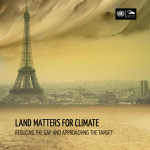The UN Convention to Combat Desertification (UNCCD) has published a brief titled, ‘Land matters for climate: Reducing the gap and approaching the target,' ahead of the 21st session of the Conference of the Parties (COP 21) to the UN Framework Convention on Climate Change (UNFCCC) to be held in Paris, France.
The publication states that additional commitments contained in the UNCCD's Land Degradation Neutrality (LDN) target − which envisages rehabilitating 12 million hectares of degraded land globally each year − could help close roughly 25% of the estimated emissions gap of 13 gigatonnes of equivalent CO2 (GtC02e), and amounts to “two thirds of the expected emissions reduction pledges of all INDCs [Intended Nationally Determined Contributions] in the year 2030.”
 11 November 2015: The UN Convention to Combat Desertification (UNCCD) has published a brief titled, ‘Land matters for climate: Reducing the gap and approaching the target,’ ahead of the 21st session of the Conference of the Parties (COP 21) to the UN Framework Convention on Climate Change (UNFCCC) to be held in Paris, France. The publication states that additional commitments contained in the UNCCD’s Land Degradation Neutrality (LDN) target − which envisages rehabilitating 12 million hectares of degraded land globally each year − could help close roughly 25% of the estimated emissions gap of 13 gigatonnes of equivalent CO2 (GtC02e), and amounts to “two-thirds of the expected emissions reduction pledges of all INDCs [Intended Nationally Determined Contributions] in the year 2030.”
11 November 2015: The UN Convention to Combat Desertification (UNCCD) has published a brief titled, ‘Land matters for climate: Reducing the gap and approaching the target,’ ahead of the 21st session of the Conference of the Parties (COP 21) to the UN Framework Convention on Climate Change (UNFCCC) to be held in Paris, France. The publication states that additional commitments contained in the UNCCD’s Land Degradation Neutrality (LDN) target − which envisages rehabilitating 12 million hectares of degraded land globally each year − could help close roughly 25% of the estimated emissions gap of 13 gigatonnes of equivalent CO2 (GtC02e), and amounts to “two-thirds of the expected emissions reduction pledges of all INDCs [Intended Nationally Determined Contributions] in the year 2030.”
The 24-page brief presents three pathways for striving to achieve the LDN target that could also translate into meaningful climate action, namely through: protecting natural carbon sinks like forests, grasslands and wetlands; adopting and scaling up sustainable land management (SLM) practices that reduce emissions, increase productivity and prevent further land-use changes; and restoring degraded ecosystems for improved resilience and long-term carbon storage. The publication stresses that some of the proposed actions “need not be expensive or complex,” noting that it can take “as little as US$20” to rehabilitate one hectare of farmland in Africa using traditional agro-forestry, water conservation, and livestock management practices.
The publication also highlights additional benefits related to improved biodiversity conservation, soil fertility, water retention and yield gains, which makes land rehabilitation a significant contributor not only to climate change, but to the overarching Sustainable Development Goals (SDGs) related to the environment, poverty reduction and food and water security.
The Brief is the first output related to the upcoming UNCCD flagship publication, the Global Land Outlook (GLO), due to be published in late 2016 or early 2017, which aims to build broad awareness that land degradation “represents one of the biggest human challenges of our time” and that “the cost of inaction is far greater than the cost of taking action.” Envisioned as the equivalent of the UN Environment Programme’s (UNEP) Global Environmental Outlook, GLO aims to provide the “first comprehensive outlook on the status and trends in the use and management of land resources worldwide.” GLO will include land management indices to enable comparisons of land management systems across countries and will be complemented by a series of working papers containing supplementary contributions and an additional vehicle for disseminating their analyses. [UNCCD Flyer] [UNCCD Publication: Land matters for climate: Reducing the gap and approaching the target] [Natural Resources Policy & Practice Story on Global Land Outlook Side Event at UNCCD 3rd Scientific Conference] [IISD RS Sources]